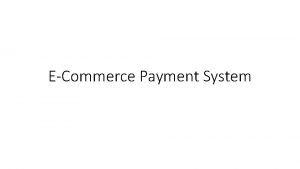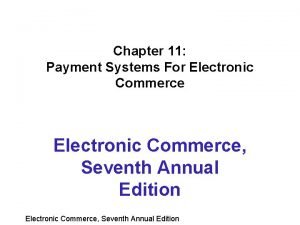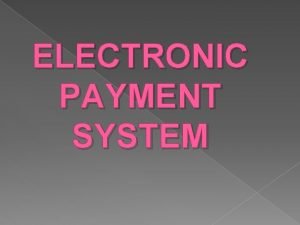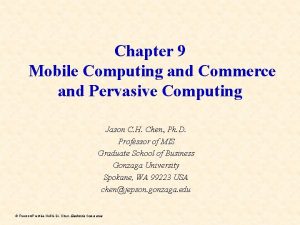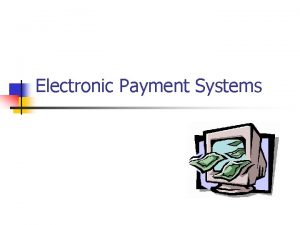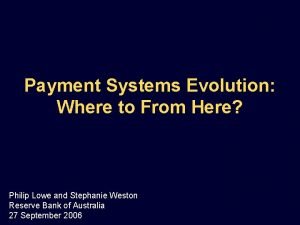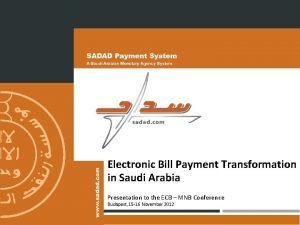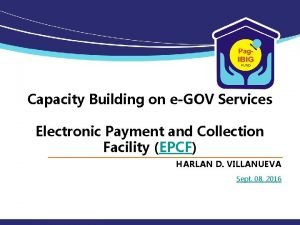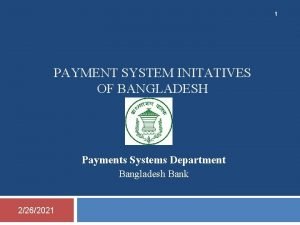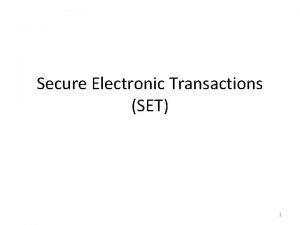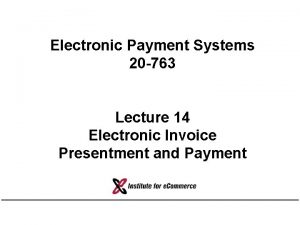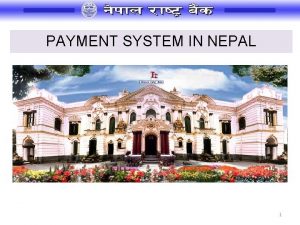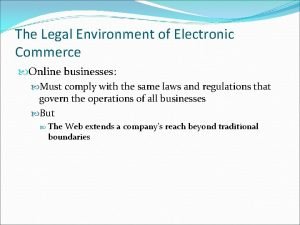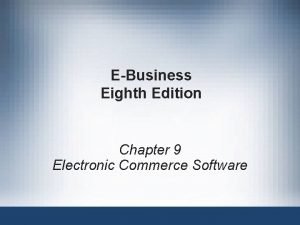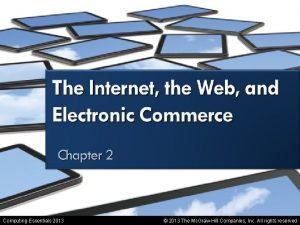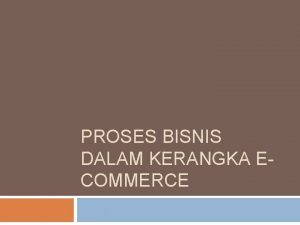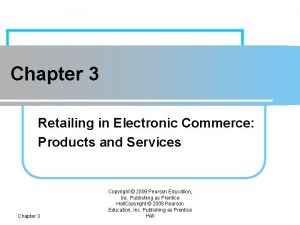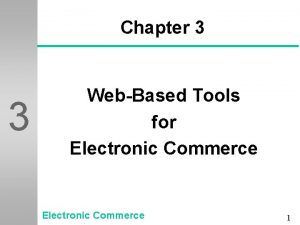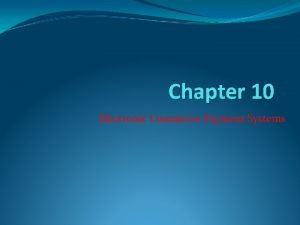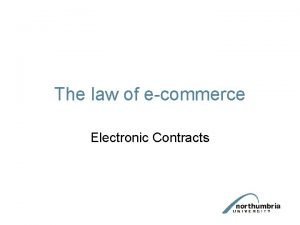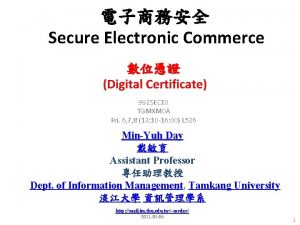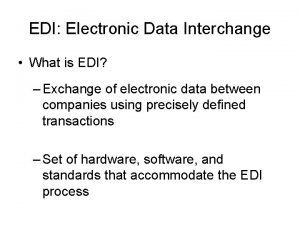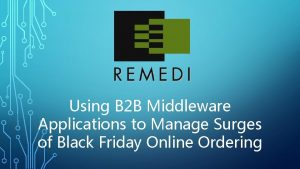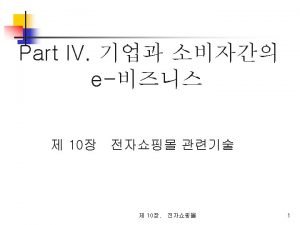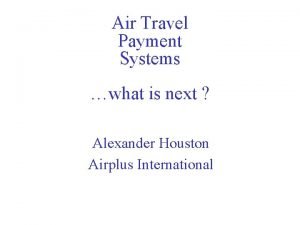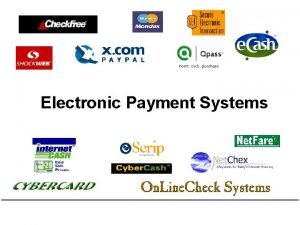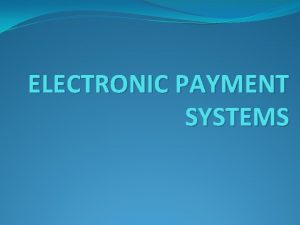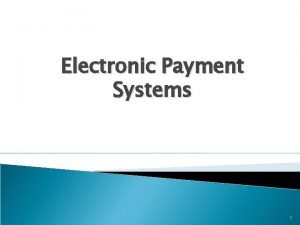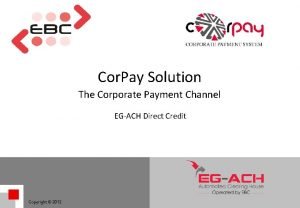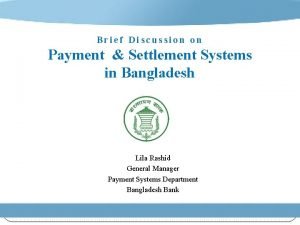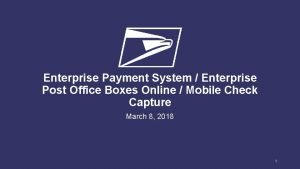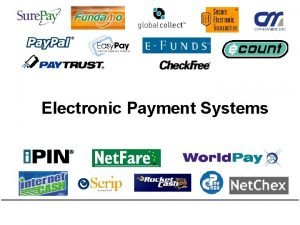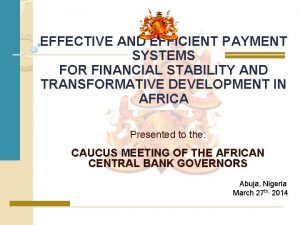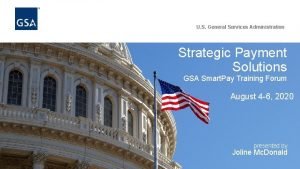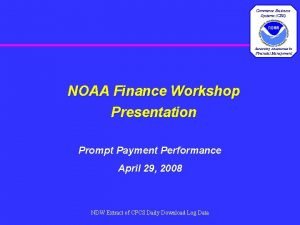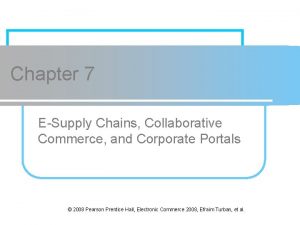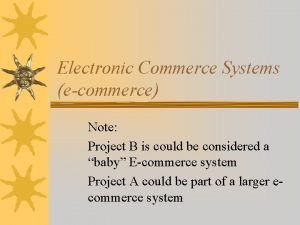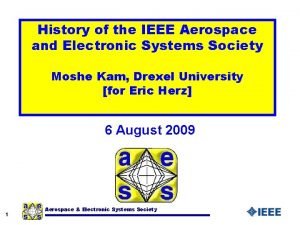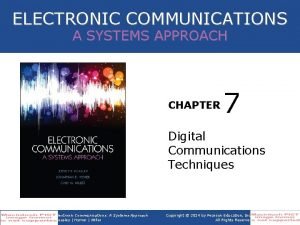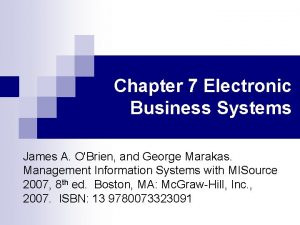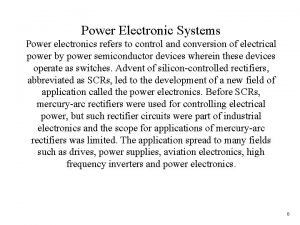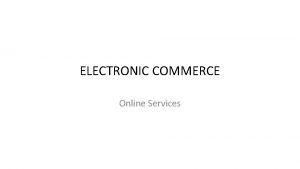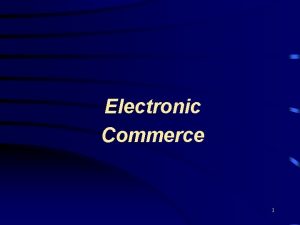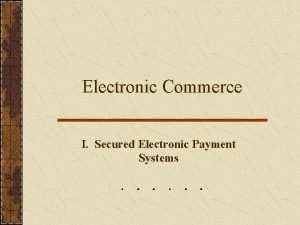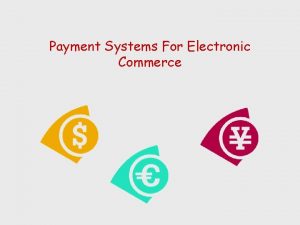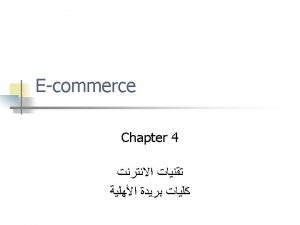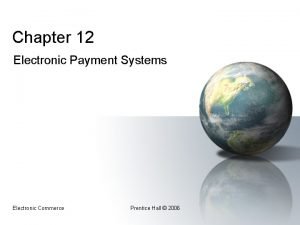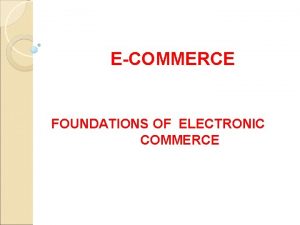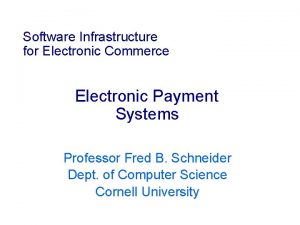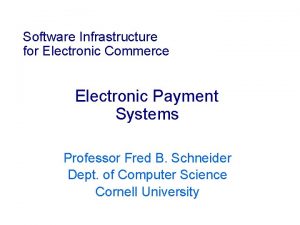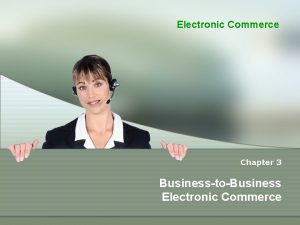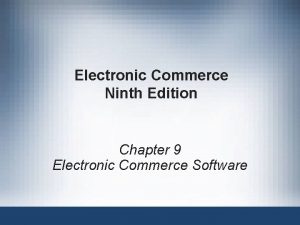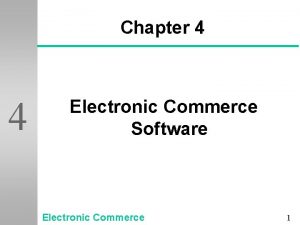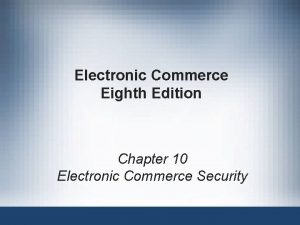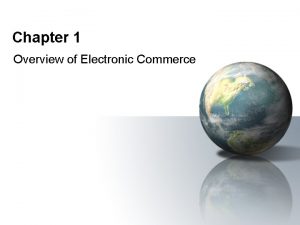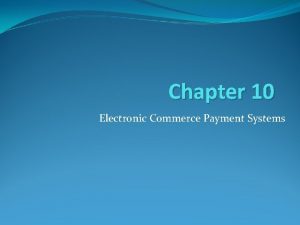Chapter 7 7 Electronic Payment Systems Electronic Commerce























































- Slides: 55

Chapter 7 7 Electronic Payment Systems Electronic Commerce 1

Objectives u Four 7 methods for collecting customer payments u Credit and debit card processing u SET protocol protections u How software wallets work u History and future of electronic cash systems, how they work and are implemented u Smart cards u Which payment systems are most popular and which are likely to gain acceptance 2

Introduction to Electronic Payment Systems u Three 7 l methods of payment currently Check, credit card, or cash u Four methods of electronic payment Electronic cash, software wallets, smart cards, and credit/debit cards l Scrip is digital cash minted by third-party organizations l 3

Electronic Cash u Primary 7 advantage is with purchase of items less than $10 Credit card transaction fees make small purchases unprofitable l Micropayments l u Payments for items costing less than $1 4

Electronic Cash Issues u E-cash 7 must allow spending only once u Must be anonymous, just like regular currency Safeguards must be in place to prevent counterfeiting l Must be independent and freely transferable regardless of nationality or storage mechanism l u Divisibility and Convenience 5

Beenz Home Page Figure 7 -1 7 6

Electronic Cash Storage u Two l methods On-line u Individual does not have possession personally of electronic cash u Trusted third party, e. g. online bank, holds customers’ cash accounts 7 l Off-line u Customer holds cash on smart card or software wallet u Fraud and double spending require tamperproof encryption 7

Cyber. Cash -- A Pioneer in Electronic Cash Figure 7 -2 7 8

Advantages and Disadvantages of Electronic Cash u Advantages l 7 l l More efficient, eventually meaning lower prices Lower transaction costs Anybody can use it, unlike credit cards, and does not require special authorization u Disadvantages l l l Tax trail non-existent, like regular cash Money laundering Susceptible to forgery 9

How Electronic Cash Works u Customer opens account with bank in person and establishes identity 7 l Thereafter, digital certificate serves as proof of identity u Once identified, bank issues e-currency and deducts amount from customer’s account (minus service fee) u Customer spends e-cash with merchant who validates it to prevent forgery or fraud u Merchant presents e-cash to issuing bank for deposit once goods or services are received 10

Electronic Cash Security u Complex cryptographic algorithms prevent double spending 7 l Anonymity is preserved unless double spending is attempted u Serial numbers can allow tracing to prevent money laundering l Does not prevent double spending, since the merchant or consumer could be at fault 11

Detecting Double Spending Figure 7 -3 7 12

Past and Present E-cash Systems u E-cash 7 not popular in U. S. , but successful in Europe and Japan l Reasons for lack of U. S. success not clear u Manner of implementation too complicated u Lack of standards and interoperable software that will run easily on a variety of hardware and software systems 13

Past and Present E-cash Systems u Checkfree l 7 Allows payment with online electronic checks u Clickshare Designed for magazine and newspaper publishers l Miscast as a micropayment only system; only one of its features l Purchases are billed to a user’s ISP, who in turn bill the customer l 14

Using Checkfree To Pay A Bill Online Figure 7 -4 7 15

Clickshare’s Home Page Figure 7 -5 7 16

Past and Present E-cash Systems u Cyber. Cash Combines features from cash and checks l Offers credit card, micropayment, and check payment services l Connects merchants directly with credit card processors to provide authorizations for transactions in real time l 7 u No delays in processing prevent insufficient ecash to pay for the transaction 17

Past and Present E-cash Systems u Cyber. Coins Stored in Cyber. Cash wallet, a software storage mechanism located on customer’s computer l Used to make purchases between. 25 c and $10 l Pay. Now -- payments made directly from checking accounts l 7 18

Cyber. Cash’s Cash. Register Service Figure 7 -6 7 19

Past and Present E-cash Systems u Digi. Cash Trailblazer in e-cash l Allowed customers to purchase goods and services using anonymous electronic cash l Recently entered Chapter 11 reorganization l 7 20

Past and Present E-cash Systems u Coin. Net Electronic tokens stored on a customer’s computer is used to make purchases l Works by installing special plug-in to a customer’s web browser l Merchants do not need special software to accept e. Coins. l e. Coin server prevents double-spending and traces transactions, but consumer is anonymous to merchant l 7 21

e. Coin. net Home Page Figure 7 -7 7 22

Past and Present E-cash Systems u Milli. Cent Developed by Digital, now part of Compaq l Electronic scrip system l Participating merchant creates and sells own scrip to broker at a discount l 7 u Consumers register with broker and buy bulk generic scrip, usually with credit card u Customers buy by converting broker scrip to vendor-specific scrip, i. e. scrip that a particular merchant will accept 23

Past and Present E-cash Systems u Milli. Cent cont’d Customers can purchase items of very low value l Brokers required for two reasons: l 7 u Small payments require aggregation to insure profitability u System is easier to use -- customer need only deal with one broker for all their scrip needs 24

Milli. Cent Demonstration Page Figure 7 -8 7 25

Electronic Wallets u Stores credit card, electronic cash, owner identification and address 7 l Makes shopping easier and more efficient u Eliminates need to repeatedly enter identifying information into forms to purchase u Works in many different stores to speed checkout l Amazon. com one of the first online merchants to eliminate repeat form-filling for purchases 26

An Electronic Checkout Counter Form Figure 7 -9 7 27

Electronic Wallets u Agile Wallet Developed by Cyber. Cash l Allows customers to enter credit card and identifying information once, stored on a central server l Information pops up in supported merchants’ payment pages, allowing oneclick payment l Does not support smart cards or Cyber. Cash, but company expects to soon l 7 28

Electronic Wallets u e. Wallet Developed by Launchpad Technologies l Free wallet software that stores credit card and personal information on users’ computer, not on a central server; info is dragged into payment form from e. Wallet l Information is encrypted and password protected l Works with Netscape and Internet Explorer l 7 29

Electronic Wallets u Microsoft Wallet Comes pre-installed in Internet Explorer 4. 0, but not in Netscape l All information is encrypted and password protected l Microsoft Wallet Merchant directory shows merchants setup to accept Microsoft Wallet l 7 30

Entering Information Into Microsoft Wallet Figure 7 -10 7 31

W 3 C Proposed Standard for Electronic Wallets u World 7 Wide Web Consortium (W 3 C) is attempting to create an extensible and interoperable method of embedding micropayment information on a web page l Extensible systems allow improvement of the system without eliminating previous work 32

W 3 C Proposed Standard for Electronic Wallets u Merchants 7 must accept several payment options to insure the widest possible Internet audience l l l Merchants must embed in their Web page payment information specific to each payment system This redundancy spurred W 3 C to develop common standards for Web page markup for all payment systems Must move quickly to prevent current methods from becoming entrenched 33

W 3 C Electronic Commerce Interest Group (ECIG) Draft Standard Architecture u Client 7 (consumer’s web browser) initiates micropayment activity Client browser includes Per Fee Link Handler module and one or more electronic wallets l New HTML tags will carry micropayment information l 34

W 3 C Proposed Micropayment HTML Tags Figure 7 -11 7 35

The ECML Standard u Electronic 7 Commerce Modeling Language (ECML) proposed standards for electronic wallets Companies forming the consortium are America Online, IBM, Microsoft, Visa, and Master. Card l Ultimate goal is for all commerce sites to accept ECML l Unclear how this standard will incorporate privacy standards W 3 C set forth l 36

Smart Cards u Plastic card containing an embedded microchip 7 Can contain cash l Over 100 times more information storage than a magnetic-striped plastic card l Information is encrypted, unlike credit cards which have account number on its face, making credit theft practically impossible l 37

Smart Cards u Available 7 for over 10 years u So far not successful in U. S. , but popular in Europe, Australia, and Japan u Unsuccessful in U. S. partly because few card readers available u Smart cards gradually reappearing in U. S. ; success depends on: l l Critical mass of smart cards that support applications Compatibility between smart cards, card-reader devices, and applications 38

Mondex Smart Card u Holds 7 and dispenses electronic cash u Developed by Master. Card International u Requires specific card reader for merchant or customer to use card over Internet u Supports micropayments as small as 3 c and works both online and off-line at stores or over the telephone 39

Mondex Smart Card 7 u Disadvantages Card carries real cash in electronic form, creating the possibility of theft l No deferred payment as with credit cards cash is dispensed immediately l 40

Mondex Smart Card Processing Figure 7 -12 7 41

Credit and Charge Cards u Credit card Used for the majority of Internet purchases l Has a preset spending limit l 7 u Charge card No spending limit l Entire amount charged due at end of billing period l u Merchants must set up merchant accounts to accept payment cards 42

Payment Acceptance and Processing u Law 7 prohibits charging payment card until merchandise is shipped u Payment card transaction requires: Merchant to authenticate payment card l Merchant must check with card issuer to ensure funds are available and to put hold on funds needed to make current charge l Settlement occurs in a few days when funds travel through banking system into merchant’s account l 43

Open and Closed Loop Systems u Closed loop systems Banks and other financial institutions serve as brokers between card users and merchants -- no other institution is involved l American Express and Discover are examples l 7 u Open loop systems Transaction is processed by third party l Visa and Master. Card are examples l 44

Setting Up Merchant Account u Merchant bank Also called acquiring bank l Does business with merchants that want to accept payment cards l Merchant receives account where they deposit card sales totals l Value of sales slips is credited to merchant’s account l 7 45

Processing Payment Cards Online u Can 7 be done automatically by software packaged with electronic commerce software u Can contract with third party to handle payment card processing Can also pick, pack, and ship products to the customer l Allows merchant to focus on web presence and supply availability l 46

Payment Processing Services u Internetsecure Provides secure credit card payment services l Supports payments with Visa and Master. Card l Provides risk management and fraud detection, and ensures all proper security for credit card transactions is maintained l Ensures all transactions are properly credited to merchant’s account l 7 47

Payment Processing Services u Tellan l 7 l l l Provides PCAuthorize for smaller commerce sites and Web. Authorize for larger enterprise-class merchant sites Both systems capture credit card information from the merchant’s form and connect directly to the bank network using dial-up or private, leased lines Bank network receives credit information, performs credit authorization, and deposits the money in the merchant’s bank account The merchant’s web site receives confirmation or rejection of the transaction, which is communicated to the customer 48

Processing a Payment Card Order Figure 7 -13 7 49

Payment Processing Services u IC l 7 l l Verify Provides electronic transaction processing for merchants for all major credit and debit cards Also allows check guarantees and verification transactions A Cyber. Cash company u Authorize. Net l Online, real time service that links merchants with issuing banks by simply inserting a small block of HTML code into their transaction page 50

Secure Electronic Transaction (SET) Protocol u Jointly 7 designed by Master. Card and Visa with backing of Microsoft, Netscape, IBM, GTE, SAIC, and others u Designed to provide security for card payments as they travel on the Internet l Contrasted with Secure Socket Layers (SSL) protocol, SET validates consumers and merchants in addition to providing secure transmission 51

Secure Electronic Transaction (SET) Protocol u Goal is single method of conducting payment transactions on the Internet 7 l Acceptance of standard has been slow u SET l l specification Uses public key cryptography and digital certificates for validating both consumers and merchants Provides privacy, data integrity, user and merchant authentication, and consumer nonrepudiation 52

SETCo’s Home Page Figure 7 -14 7 53

SET Payment Transactions u SET-protected l 7 l l payments work like this: Consumer makes purchase by sending encrypted financial information along with digital certificate Merchant’s website transfers the information to a payment card processing center while a Certification Authority certifies digital certificate belongs to sender Payment card-processing center routes transaction to credit card issuer for approval Merchant receives approval and credit card is charged Merchant ships merchandise and adds transaction amount for deposit into merchant’s account 54

SET Protocol u So 7 far has received lukewarm reception u 80 percent of SET activities are in Europe and Asian countries u Problems with SET Not easy to implement l Not as inexpensive as expected l Clumsy l Not tried and tested, and often not needed l 55
 Electronic commerce payment systems
Electronic commerce payment systems Payment systems for electronic commerce
Payment systems for electronic commerce Meaning of e payment system
Meaning of e payment system Chapter 2 the internet the web and electronic commerce
Chapter 2 the internet the web and electronic commerce Location-based commerce (l-commerce)
Location-based commerce (l-commerce) Objectives of digital payment
Objectives of digital payment What is eipp
What is eipp Evolution of electronic payment system
Evolution of electronic payment system Payer payee
Payer payee Electronic bill presentation and payment
Electronic bill presentation and payment Egov chinabank
Egov chinabank Electronic payment system in bangladesh
Electronic payment system in bangladesh Secure electronic transaction
Secure electronic transaction What is eipp
What is eipp Payment system in nepal
Payment system in nepal The legal environment of electronic commerce
The legal environment of electronic commerce Enterprise-class electronic commerce software:
Enterprise-class electronic commerce software: The internet the web and electronic commerce
The internet the web and electronic commerce Proses bisnis dalam kerangka electronic commerce
Proses bisnis dalam kerangka electronic commerce Electronic commerce software
Electronic commerce software Retailing in electronic commerce products and services
Retailing in electronic commerce products and services Web based tools for electronic commerce
Web based tools for electronic commerce E commerce electronic data interchange
E commerce electronic data interchange Integrity in e commerce
Integrity in e commerce Electronic commerce payments inc
Electronic commerce payments inc Uncitral model law on electronic commerce
Uncitral model law on electronic commerce Tgmxm
Tgmxm Advantages of edi in e commerce
Advantages of edi in e commerce Pure electronic commerce
Pure electronic commerce Remedi electronic commerce group
Remedi electronic commerce group Explain generic framework of e commerce
Explain generic framework of e commerce Car wash payment systems
Car wash payment systems Cambridge payment systems
Cambridge payment systems Payment systems in botswana
Payment systems in botswana Travel payment systems
Travel payment systems Payment systems outline
Payment systems outline History of payment systems
History of payment systems Payment systems outline
Payment systems outline Cor vi ach
Cor vi ach Payment systems and working hours
Payment systems and working hours Eft payment bangladesh
Eft payment bangladesh Enterprise po boxes online
Enterprise po boxes online Payment systems outline
Payment systems outline Payment systems efficiency
Payment systems efficiency Buyer initiated payments bip
Buyer initiated payments bip Cbs report sample
Cbs report sample Collaborative commerce examples
Collaborative commerce examples Internet commerce systems
Internet commerce systems Scrip exchange
Scrip exchange Electronic field production
Electronic field production Principles of electronic communication systems 3rd edition
Principles of electronic communication systems 3rd edition Aerospace and electronic systems society
Aerospace and electronic systems society Electronic communications a systems approach
Electronic communications a systems approach Electronic business systems
Electronic business systems Electronic business systems
Electronic business systems Power electronic systems
Power electronic systems
